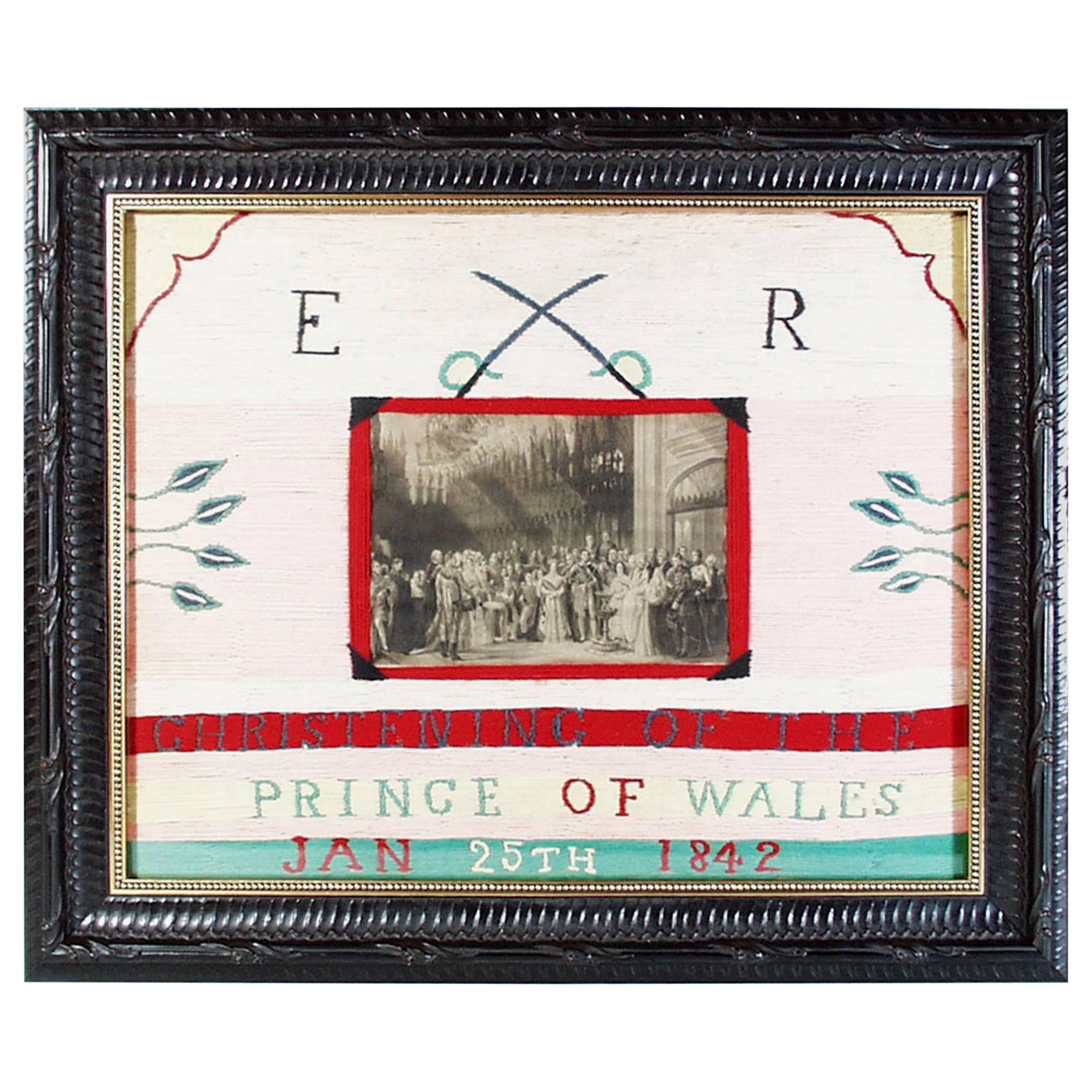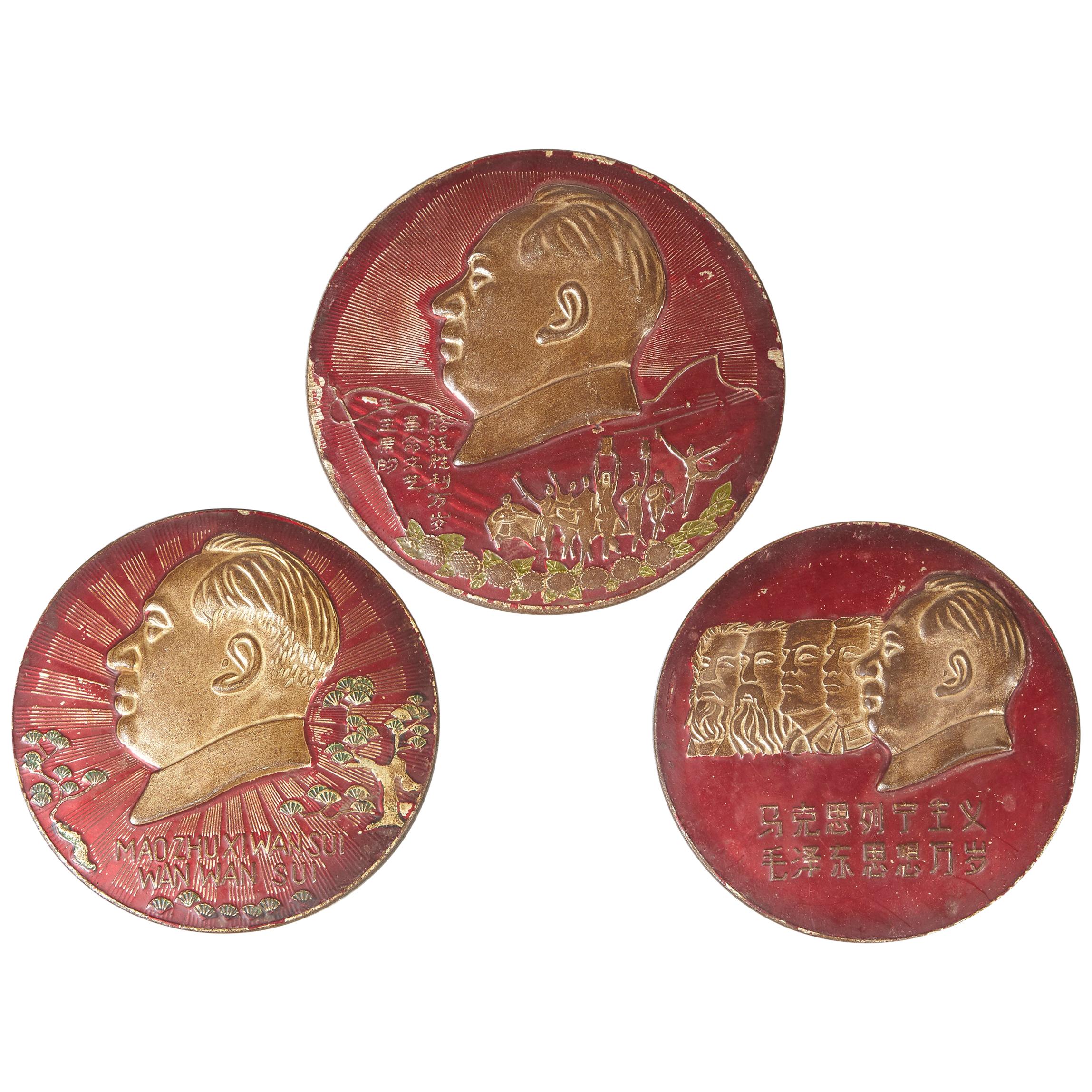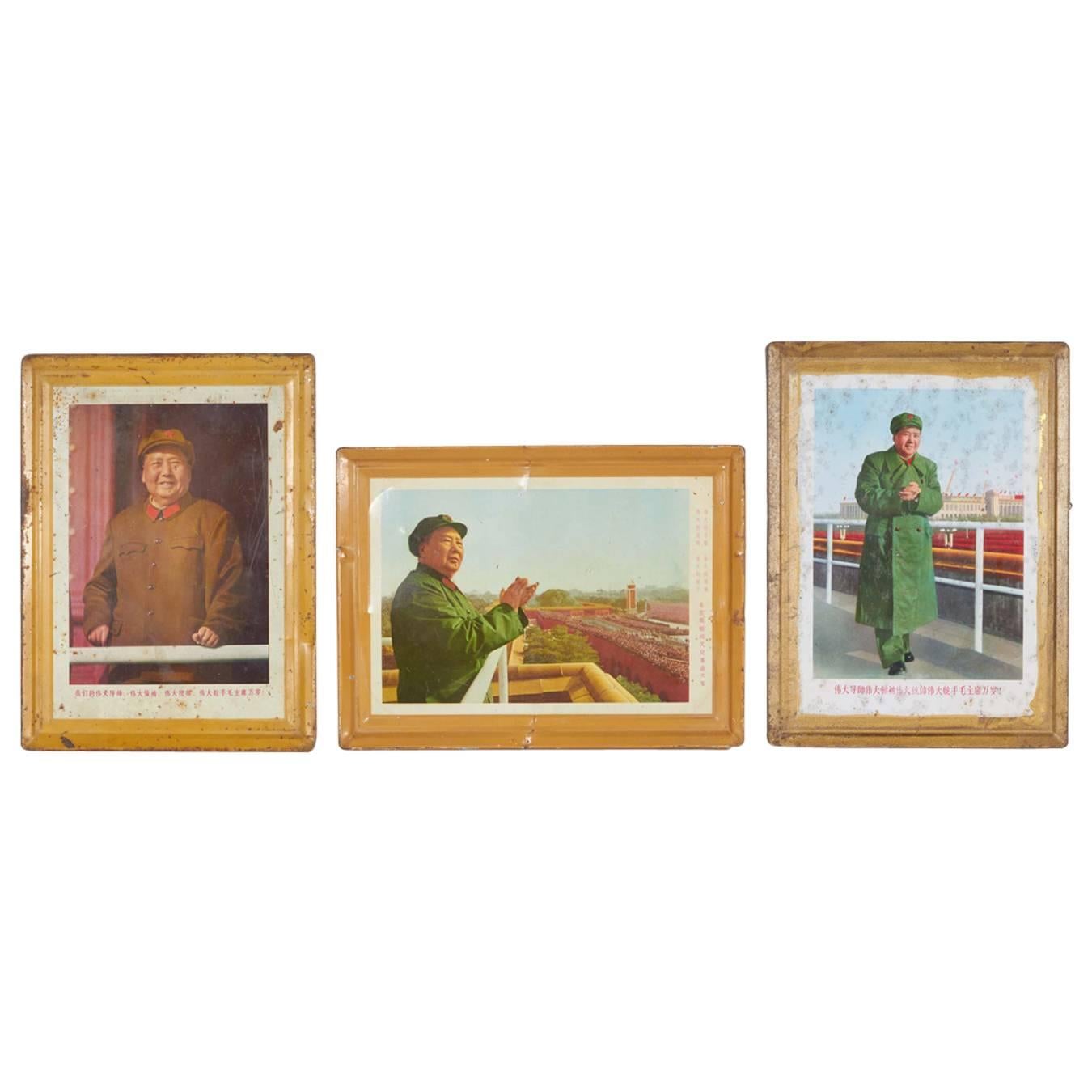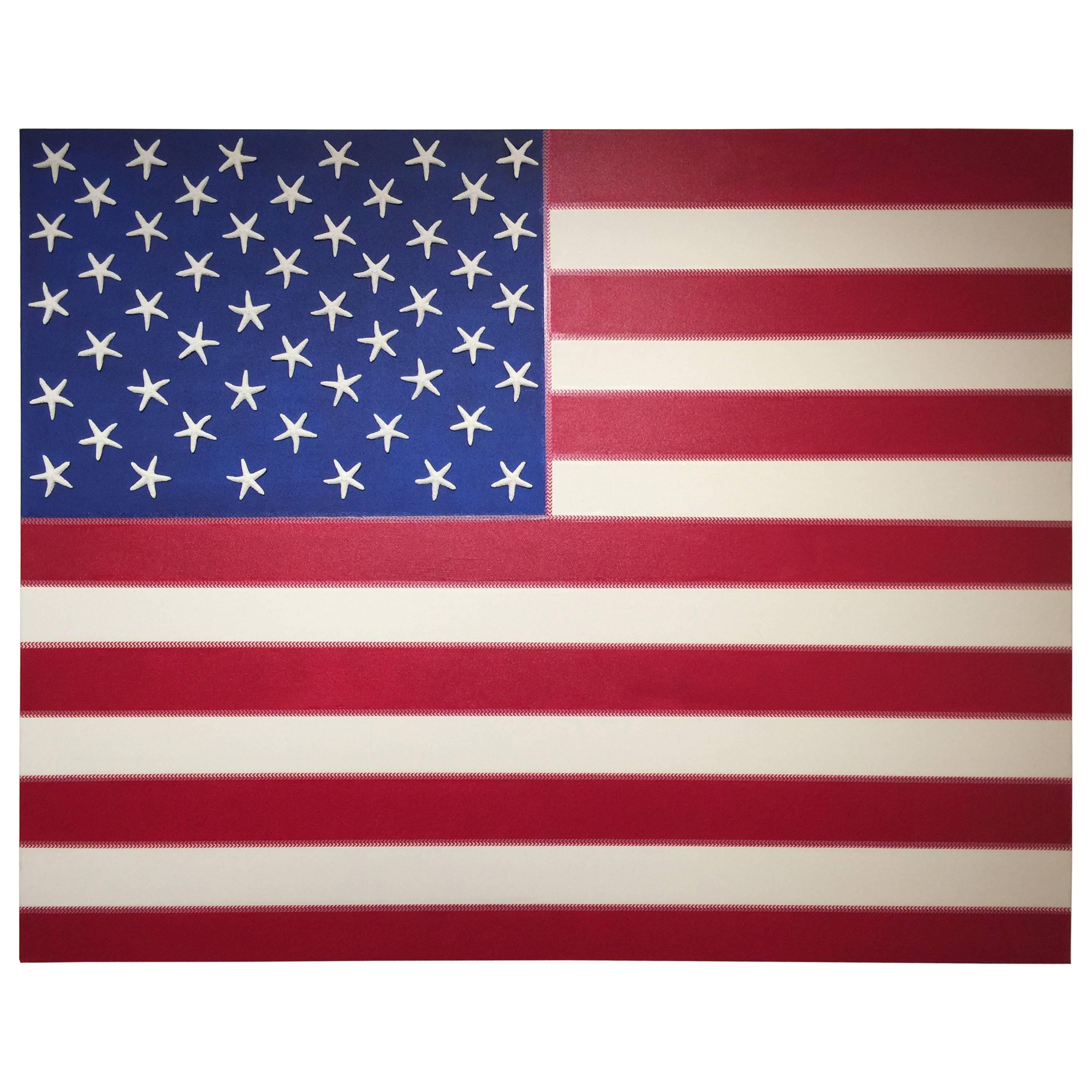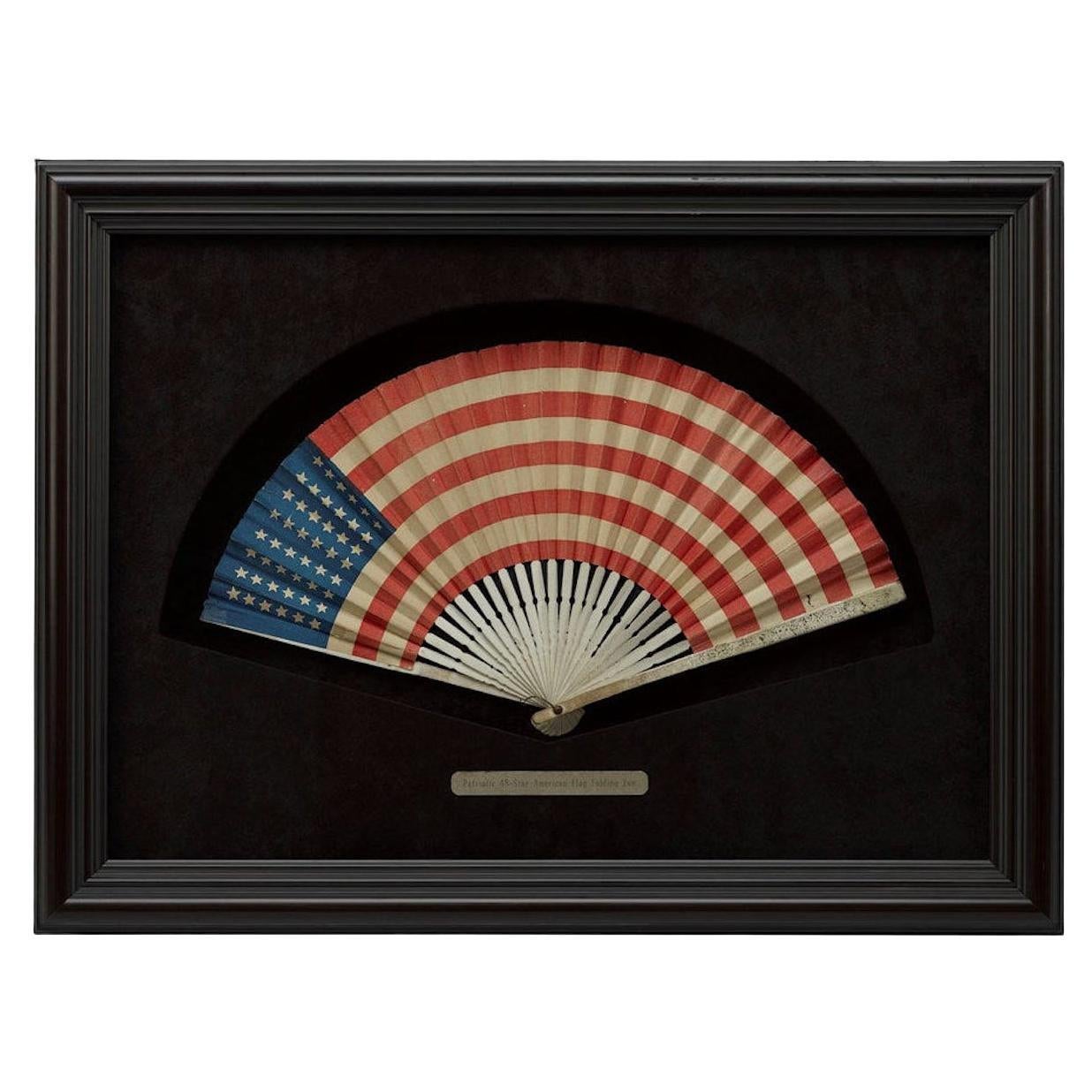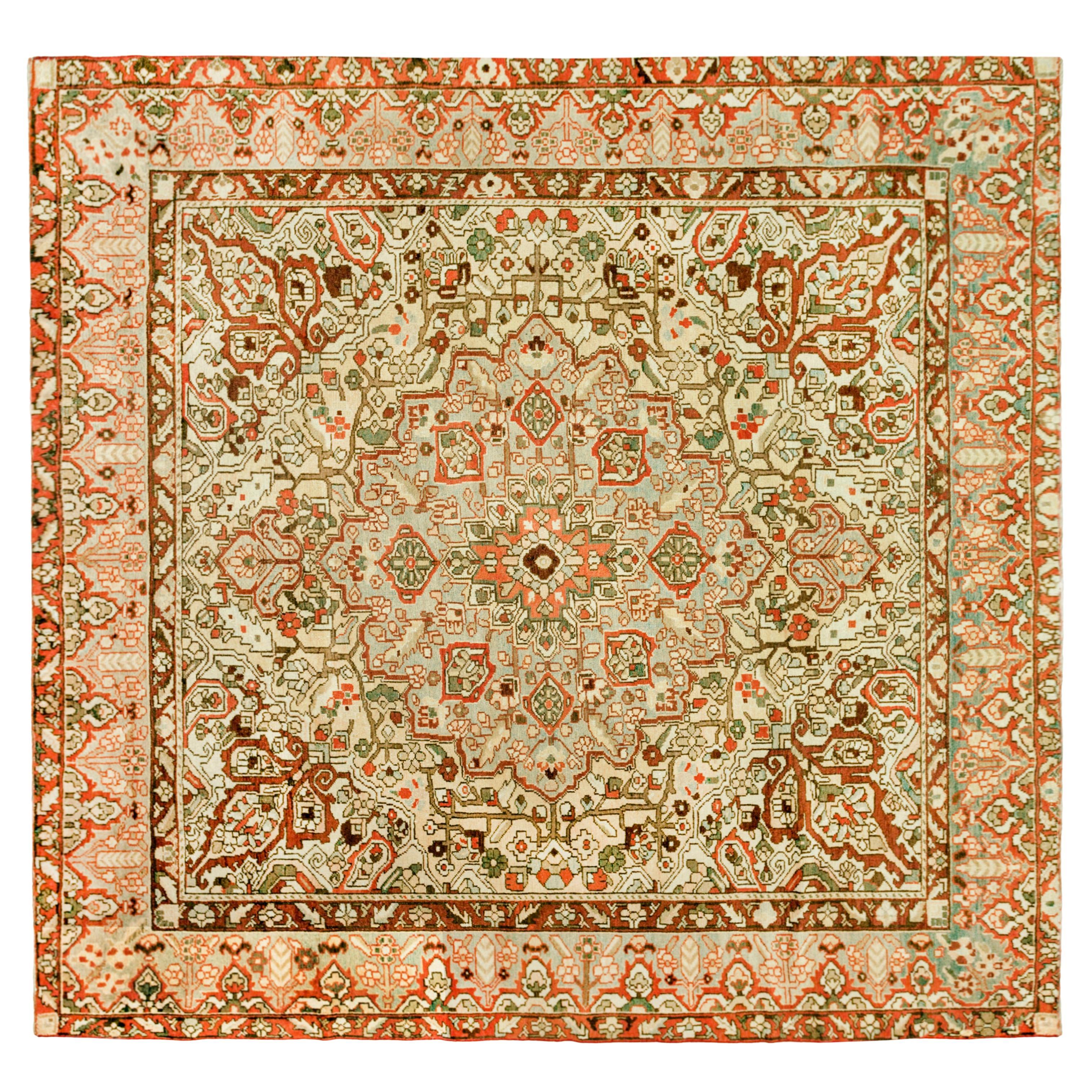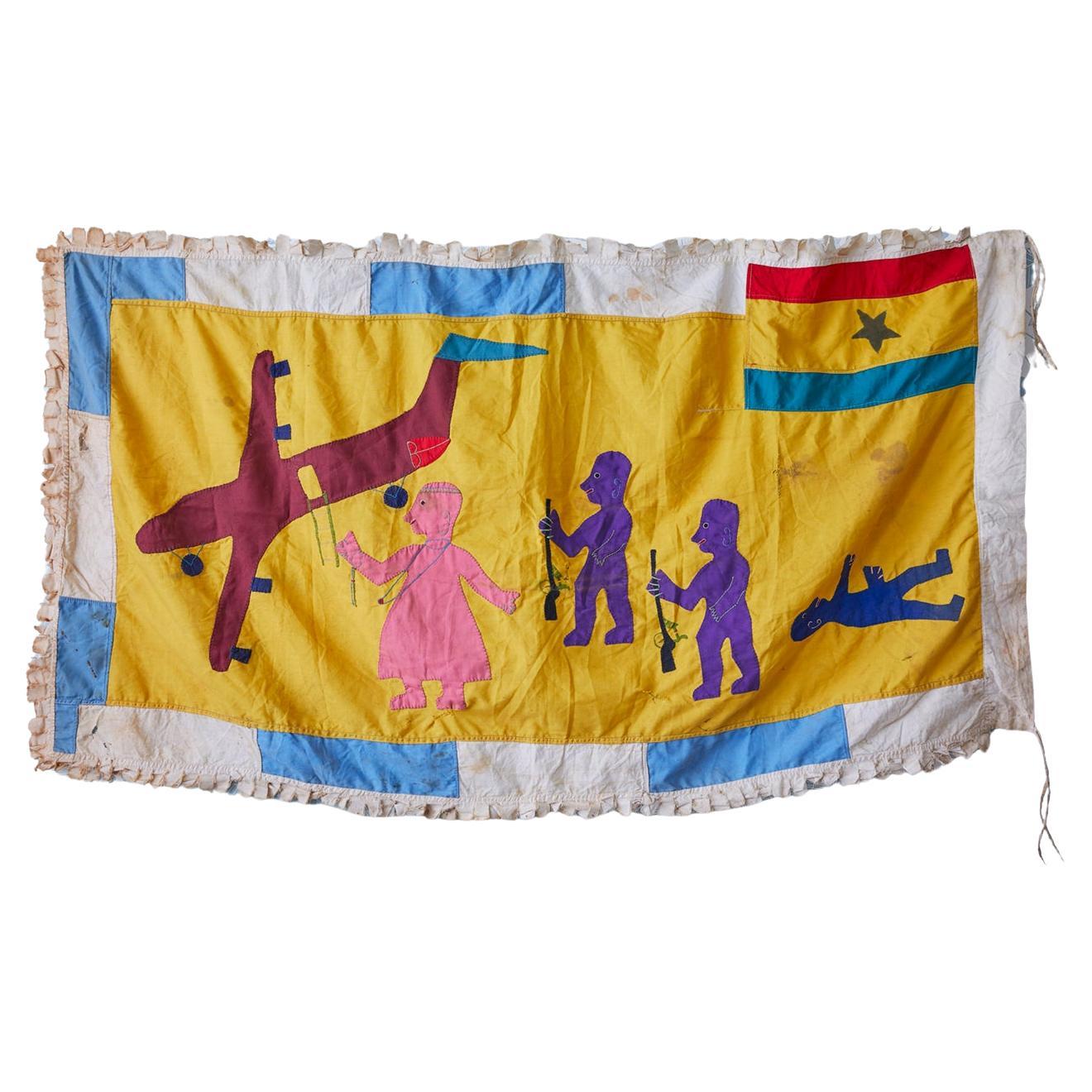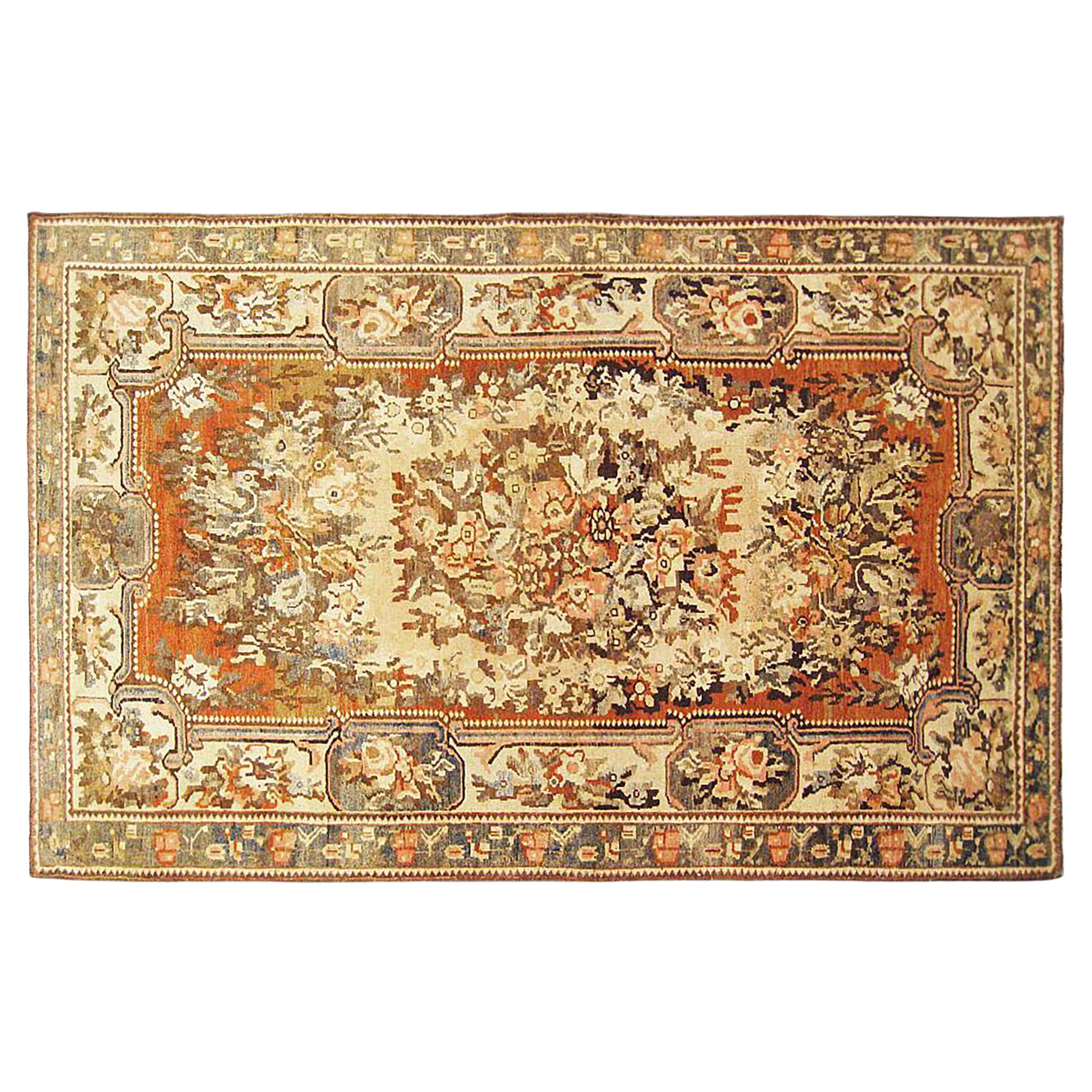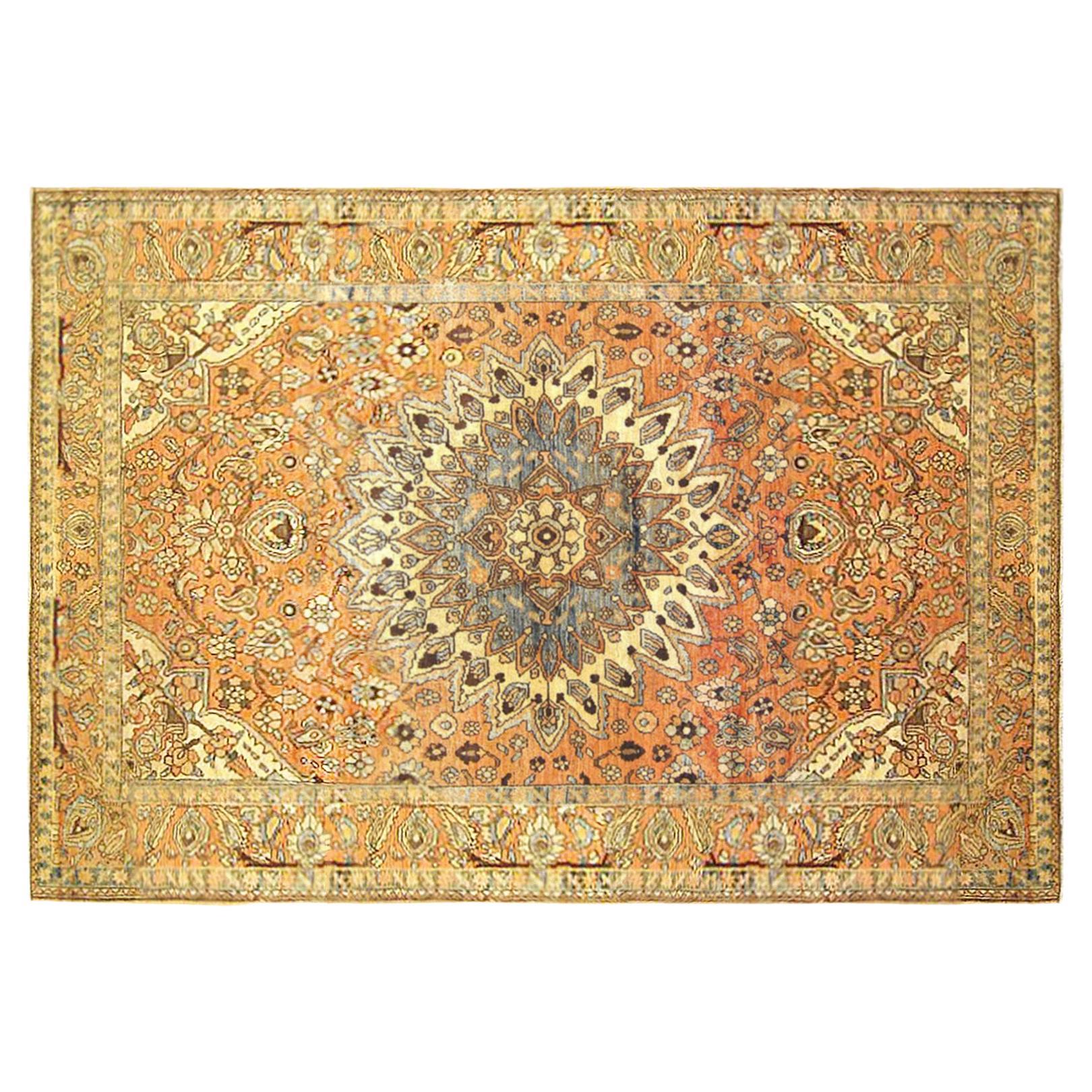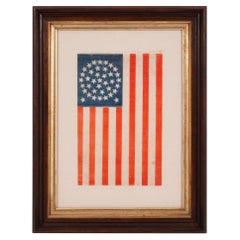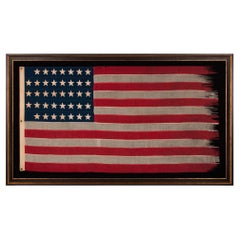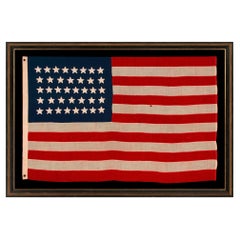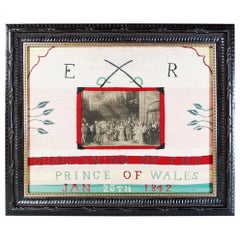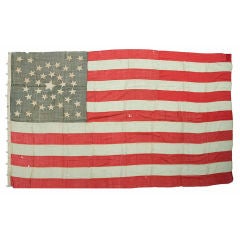
38 Star Flag In A Medallion Configuration
View Similar Items
Want more images or videos?
Request additional images or videos from the seller
1 of 5
38 Star Flag In A Medallion Configuration
About the Item
38 star American national flag in a large size with some unusual and attractive features. The stars are arranged in a medallion pattern that consists of two concentric wreaths of stars, surrounding a larger center star, with triangular groups of three stars flanking in each corner. A traditional medallion design has one, two, or three wreaths, with a star in the center and just one star in each corner. Variations on this design with multiple stars in each corner are much more rare and usually more visually interesting. That is the case with this example, where the entire device looks a bit like a giant gear, or maybe the footprint of a large round building with four pointed towers. Whatever the case may be to any given observer, it's safe to say that it's both beautiful and distinctly different from the norm, which makes it both desirable and academically intriguing. One theory on the use of triangles of three stars in a centennial era flag is that the illustration might represent the tri-corner hats so popular with patriots during the Revolutionary War. This could as easily be fiction as fact, but since there was no official star pattern for the flag in early America, many examples exist where liberties appear to have been taken by the makers of flags to include various types of patriotic and political symbolism.
The canton of the flag and the white stripes are made of wool bunting, while the red stripes are made of fine, merino wool. The stars are made of cotton and double-appliquéd, meaning that they are applied to both sides of the canton. All of the piecework and appliqué work was done with a treadle machine. There is a sailcloth canvas binding along the hoist, along which are 13 brass rings, through which a rope would have been threaded for hoisting. The binding was applied with a treadle machine and the rings were hand-sewn with a whip stitch.
Note how the color of the blue canton has faded to a dusty blue-green. This is due to the use of a fugitive dye, more so than to light exposure and the passage of time. The result is a flag with an interesting color and patina that shows its age in what some call a very desirable fashion.
The 38th state, Colorado, joined the Union on August 1st, 1876. This was the year of our nation’s centennial of independence from Great Britain. Although 37 was the official star count in 1876, flag-making was a competitive venture and no one wanted to be making 37 star flags when others were making 38’s. It is for this reason that 38 and 13 (to reference the original 13 colonies) are the two star counts most often seen during the centennial events.
The 38 star flag was generally used until 1889, when four new states joined the Union. Decorative star patterns, however, like this one, tend to be seen on 38 star flags that were made specifically for 1876 events, such as the Centennial International Exposition in Philadelphia, a six-month long, World’s Fair event, held in conjunction with the nation’s anniversary.
Mounting: The flag has not yet been mounted. We have a full time conservation staff, so feel free to inquire about mounting and framing options.
Condition: There are minor tears and losses throughout, accompanied by very minor foxing and staining. Use of a fugitive dye in the canton has caused it to fade to a dusty blue-green. This is not exactly a bad trait among collectors. I have clients that actually prefer flags with cantons in this shade, which tend to look terrific on a black mount. many of my clients prefer flags that show their age and history of use.
- Place of Origin:
- Period:
- Date of Manufacture:1876-1889
- Condition:See Item Description.
- Seller Location:York County, PA
- Reference Number:Seller: 38j-9151stDibs: U1109308497462
About the Seller
5.0
Recognized Seller
These prestigious sellers are industry leaders and represent the highest echelon for item quality and design.
Established in 1991
1stDibs seller since 2008
61 sales on 1stDibs
Typical response time: 10 hours
More From This SellerView All
- 38 Star Parade Flag with Stars in a Medallion Configuration, ca 1876-1889Located in York County, PA38 STARS IN A MEDALLION CONFIGURATION WITH 2 OUTLIERS, ON AN ANTIQUE AMERICAN FLAG WITH VIBRANT COLORATION, REFLECTS COLORADO STATEHOOD, 1876-1889, ILLUSTRATED IN “THE STARS & STRIPES: FABRIC OF THE AMERICAN SPIRIT” by RICHARD PIERCE, 2005 38 star American parade flag, printed on coarse, glazed cotton. The stars are arranged in a triple-wreath form of the medallion configuration, with a single center star and two stars flanking outside the basic pattern, toward the fly end. Most circular medallion patterns of this sort exhibit four flanking stars beyond the consecutive wreaths, one in each corner. The inclusion of only two was intentional, allowing for the easy addition of two more stars. Flag-makers knew that more Western Territories were soon to be added and eagerly anticipated their arrival. Use of fewer than four outliers was popular in 38 star parade flags, but is rarely encountered in other star counts. Note how the vibrant, chromatic luster of the orange stripes provides striking contrast with the blue canton, and how this contributes to the flag's beautiful presentation. Many parade flags in this star count have red stripes that lean heavily toward orange. This was common across printed flags produced between the 1850's and the 38 star period, phasing out in the last decade of the 19th century. Colorado became the 38th state on August 1st, 1876. This was the year of our nation’s 100-year anniversary of independence. Per the Third Flag Act of 1818, stars were not officially added until the 4th of July following a state's addition. For this reason, 37 was the official star count for the American flag in 1876. Flag-making was a competitive venture, however, and few flag-makers would have been continuing to produce 37 star flags when their competitors were making 38’s. It is for this reason that 38 and 13 stars (to represent the original 13 colonies) are more often seen at the Centennial International Exposition, the six-month long World’s Fair held in Philadelphia in honor of the event. Some flag-makers would have been adding a star for the 38th state even before it entered the Union, in the early part of 1876 or even prior. In fact, many makers of parade flags were actually producing 39 star flags, in hopeful anticipation of the addition of two more Western Territories instead of one. But the 39th state would not join the Union for another 13 years, when the Dakota Territory entered as two states on the same day. The 38 star flag generally fell from use at that time, though it technically remained official until July 3rd, 1890. President Ulysses S. Grant was in office when the first 38 star flags would have appeared. The list of presidents serving during the period when the 38 star flag was actually official, include Rutherford B. Hayes, James Garfield...Category
Antique Late 19th Century American Political and Patriotic Memorabilia
MaterialsCotton
Price Upon Request - 38 Star American Flag, Stars in Notched Pattern, ca 1876-1889Located in York County, PA38 HAND-SEWN STARS IN A "NOTCHED" PATTERN, ON AN ANTIQUE AMERICAN FLAG WITH BEAUTIFUL WEAR FROM HAVING BEEN EXTENSIVELY FLOWN, MADE AT THE TIME WHEN COLORADO WAS THE MOST RECENT STATE TO JOIN THE UNION, 1876-1889 38 star Antique American flag, made during the period when Colorado was the most recent state to join the Union. The stars are arranged in what is known as a "notched" pattern, in which two spaces were left open along the hoist end, in the first and last rows, in anticipation that two more Western Territories would soon join the Union. The latter 19th century was a time of when much of the land in and about the Continental Divide was formalized into states, and there was continual speculation about which ones would be accepted next, and with what boundaries. The stars of the flag are made of cotton and are double-appliquéd (applied to both sides) with a lineal, treadle stitch. The canton and stripes of the flag are made of wool bunting that has been pieced with treadle stitching. The canton was constructed from five separate lengths of fabric, which is an unusual feature, though hardly unknown. To each of these a row of stars was sewn. This manner of construction is sometimes encountered and tends to be an early trait, at least when it occurs in flags of this scale and smaller. When encountered, it also seems to have been preferred in flags meant for maritime use. While the feature does not by any means guarantee this fact, it is a reasonable, educated guess, based upon my examination of many other examples. A flag with a 5-piece canton, such as this, would have been less likelihood to stretch, with increased structural integrity. The alternative is that this was simply an example made when there were at least five pieces of leftover fabric, of a reasonable size to made individual rows, and that what it actually demonstrates is the careful conservation of scarce resources. There is a sailcloth canvas binding along the hoist, with 3 brass grommets, evenly spaced. Perhaps the best feature of the flag is the evidence it displays of having been extensively flown, with the fly end whipped out from wind exposure. While many flags display damage from a combination of having been flown, exposure to the elements, various mishaps, and improper storage, very few exhibit wear such as this, which is both endearingly and visually attractive. This one shows its age beautifully, whipped out along the fly end, with losses that convey an element of movement, that most flags don’t capture in the state in which they survive. Colorado became the 38th state on August 1st, 1876. This was the year of our nation’s 100-year anniversary of independence. Per the Third Flag Act of 1818, stars were not officially added until the 4th of July following a state's addition. For this reason, 37 was the official star count for the American flag in 1876. Flag-making was a competitive venture, however, and few flag-makers would have been continuing to produce 37 star flags, when their competitors were making 38’s. It is for this reason that 38 and 13 stars (to represent the original 13 colonies...Category
Antique Late 19th Century American Political and Patriotic Memorabilia
MaterialsWool
Price Upon Request - 38 Star Antique American Flag, Colorado Statehood, ca 1876-1889Located in York County, PA38 STAR ANTIQUE AMERICAN FLAG WITH HAND-SEWN STARS IN AN 8-7-8-7-8 PATTERN OF JUSTIFIED ROWS, MADE IN THE PERIOD WHEN COLORADO WAS THE MOST RECENT STATE TO JOIN THE UNION, 1876-1889 ...Category
Antique Late 19th Century American Political and Patriotic Memorabilia
MaterialsWool
Price Upon Request - 38 Star Parade Flag with Whimsical 6-Pointed Stars, Colorado StatehoodLocated in York County, PA38 WHIMSICAL STARS, WITH 6-POINTED PROFILES, SIMILAR TO THE STAR OF DAVID, ON AN ANTIQUE AMERICAN FLAG OF THE CENTENNIAL ERA; A REMARKABLE SPECIMEN, ONE-OF-A-KIND AMONG KNOWN EXAMPLE...Category
Antique Late 19th Century American Political and Patriotic Memorabilia
MaterialsCotton
Price Upon Request - 38 Star Antique American Flag, Colorado Statehood, ca 1876-1889Located in York County, PA38 star antique American parade flag with scattered star orientation, made of silk, with generous scale and vivid colors, Colorado Statehood, 1876-1889 38 star American national p...Category
Antique Late 19th Century American Political and Patriotic Memorabilia
MaterialsSilk
Price Upon Request - 38 Star Antique Flag, Stars in Double Wreath Pattern, Colorado Statehood 1876-89Located in York County, PA38 STAR ANTIQUE AMERICAN FLAG WITH A DOUBLE-WREATH CONFIGURATION THAT FEATURES AN ENORMOUS CENTER STAR, REFLECTS THE PERIOD OF COLORADO STATEHOOD, 1876-1889: 38 star American national flag, made entirely of plain weave cotton. The stars are arranged in a medallion configuration. This features an enormous center star, surrounded by two wreaths of much smaller stars, with a flanking star in each corner of the blue canton. The sort of disparity here, present in the scale of the large star, versus those around it, is both exceptionally unusual and graphically dynamic. Colorado became the 38th state on August 1st, 1876. This was the year of our nation’s centennial. Per the Third Flag Act of 1818, stars were not officially added until the 4th of July following a state's addition. For this reason, 37 remained the official star count for the American flag until part way through the following year. Flag-making was a competitive venture, however, and few flag-makers would have continued to produce 37 star flags when their competitors were making 38’s. Many flag-makers added a 38th star before Colorado entered the Union, in the early part of 1876, or possibly even prior. In fact, many makers of printed flags, called parade flags or hand-wavers, were actually producing flags in the 39 star count, in hopeful anticipation of the addition of two more Western Territories instead of one. It is for these reasons that 38, 39, and 13 stars, to representing the original 13 colonies, are most often seen on flags displayed at the Centennial International Exhibition. Hosted in Philadelphia, this enormous event was our nation’s first World’s Fair, lasted for a duration of six months, and served as the nucleus of celebrations held to honor America’s 100-year anniversary of independence. The 38 star flag became official on July 4th, 1877 and was generally used until the 39th state was added in November of 1889. This is probably a homemade flag, though sewn by a very skilled hand, or possibly, by two different individuals. The stripes are pieced and sewn entirely by hand, with remarkable care and precision. The canton is constructed of two lengths of blue fabric, that have been joined with treadle stitching. This was joined to the striped field by hand. The stars are double-appliquéd (applied to both sides) with treadle stitching. There is a treadle-sewn, cotton binding along the hoist, with five, hand-sewn grommets. It is extremely unusual to encounter this combination of sewing methods. Soon after the sewing machine was mass-marketed, in the mid-1850’s, flag-makers both public and private made good use of treadle machines, to join stripes, when constructing American flags. During the Civil War (1861-65), most stripes were treadle-sewn. Stars were another matter. Until the advent of electric machines...Category
Antique Late 19th Century American Political and Patriotic Memorabilia
MaterialsCotton
You May Also Like
- Christening of the Prince of Wales Woolwork Picture, Dated 1842Located in Downingtown, PAEnglish Royal Woolwork Picture, Titled E R/ Christening of the/Prince of Wales/Jan 25th 1842. A rare woolwork picture in bands of white, pink, red and green centered with a black and white picture...Category
Antique Mid-19th Century English Folk Art Decorative Art
MaterialsWool
- Three Embossed Metal Cultural Revolution Plaques with Images of MaoLocated in New York, NYThree cultural revolution period embossed metal plaques, each with the image of Chairman Mao, one plaque also including images of the leaders of Russian communism. Priced and sold ...Category
Late 20th Century Chinese Decorative Art
MaterialsMetal
- Set of Mao Cultural Revolution Portraits on TinLocated in New York, NYA set of three small striking Mao cultural revolution portraits on tin. Great historical pieces, China, circa 1960s. P394a.Category
Vintage 1960s Chinese Decorative Art
MaterialsTin
- J. WOHNSEIDLER American Flag No. 1, 2017 Acrylic on CanvasLocated in New York, NYAmerican Flag No. 1 by J. Wohnseidler. Arcylic on canvas with hand-applied starfish. Unframed. Signed/titled/dated by artist on back. Measures: 48 inches L x 36 inches H x 1.5 inches D.Category
2010s American Contemporary Art
MaterialsCanvas, Acrylic
- Patriotic 48-Star American Flag Folding FanLocated in Colorado Springs, COPresented is a printed folding fan featuring the American Flag, which dates to the early 20th century. With 48 printed stars on the fan’s canton, the fan celebrates New Mexico and Arizona statehood. The fan’s design is completed with 13 alternating red and white stripes across its white sticks and guard. The 48-star flag had a fly date of 47 years, from July 4, 1912 to July 3, 1958. Prior to the introduction of the 48-star flag with the admission of New Mexico and Arizona to the Union in 1912, no legislation existed regarding the official proportions, sizes, and pattern for stars on the American flag. As a result, many Americans designed the starry canton of their homemade flags to their own whim, in medallion, spiral, and flower star configurations. Coinciding with the introduction of the 48 star flag in 1912, President William Howard Taft...Category
Early 20th Century Decorative Art
MaterialsPaper
- Framed Yacht "Y" Signal FlagLocated in Norwell, MAFramed yacht Signal flag representing "Y". Alternating red and gold stripes. Matted and framed. Dimensions: 20" H x 25" L.Category
20th Century Decorative Art
